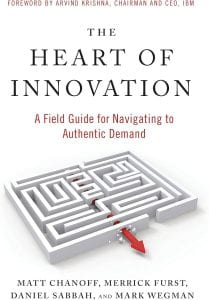
“Authentic demand is the motivating force behind success in innovation.”
By Brianna Anderson
Academics and business leaders want to create meaningful innovations that make an impact. But even the most helpful and unique innovations often fail to attract the interest of potential customers. For every Facebook and Netflix, countless other startups and projects are met with indifference. So, what sets successful innovations apart from unsuccessful ones?
Like many innovators, Dr. Mary Lynn Realff faced this question when she founded the Effective Team Dynamics Initiative (ETD). She invented a ground-breaking training program to enhance student collaboration. However, students, her target audience, often overlooked her solution, even when they struggled with group projects. Dr. Realff knew that she had to find a new way to market her method if she wanted ETD to succeed.
The Heart of Innovation: A Field Guide for Navigating Authentic Demand traces Dr. Realff and other innovators’ paths to success. Authors Matt Chanoff, Merrick Furst, Daniel Sabbah, and Mark Wegman argue that authentic demand is the cornerstone of innovation. They write, “Successful innovation also must connect with the deep selves, the motivations, the pride, validation, ambition, et. cetera of the people from whom the innovation is intended. Not only the innovator’s deep gladness, but also the world’s great hunger” (2).
Dr. Realff uncovered authentic demand for ETD when she began searching for a new target audience. She interviewed professors about the challenges they faced and noticed a recurring theme: “Caring about their students or being seen by the students as caring seemed to matter. The way Mary Lynn was talking about her work on team dynamics began to predictably provoke professors into voicing worries about students thinking they didn’t care” (153).
This revelation helped Dr. Realff reconceptualize the audience and mission of ETD. Instead of marketing the program to students, she appealed to professors’ desire to show students they cared. She created a new pitch for the program: “Do you know that when you tell students to just go figure it out because they will need to in the real world, they think you are saying you don’t care about them? Give me two hours in one of your classes, and I can help with that” (153).
Changing her target audience allowed Dr. Realff to tap into authentic demand for her training. ETD has flourished since then, serving thousands of students and faculty. Dr. Realff has also provided training at the University of Texas San Antonio, the University of Wisconsin Madison, Sagrado University Corazon, the University of Georgia, and the Okinawa Institute of Science and Technology.
The Heart of Innovation also explores case studies from startups and small companies, large corporations, and nonprofits. For each example, the authors explore how the innovators discovered authentic demand for their products and services, either accidentally or deliberately. The book also discusses the characteristics of successful innovation, arguing, “An innovation always involves a change in behavior. It’s a sustainable, repeatable change that results in a new equilibrium, a change in the form of the culture itself” (39).
The Heart of Innovation is an interdisciplinary collaboration written by four seasoned innovators: Matt Chanoff, an angel investor and co-founder of Flashpoint at Georgia Tech; Merrick Furst, a tenured professor of computer science at Georgia Tech; Daniel Sabbah, who had a forty-year career at IBM before shifting to consulting; and Mark Wegman, a leading scientist and innovator at IBM. Pick up a copy today to learn more about the evolution of ETD and the art of innovation

Leave a Reply